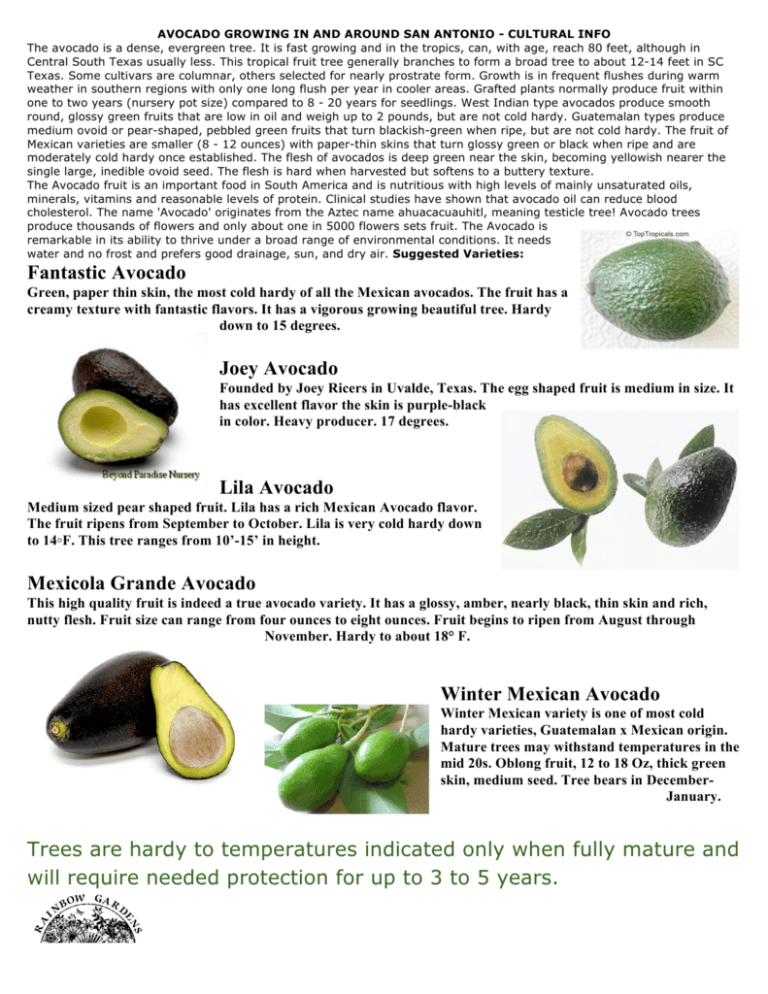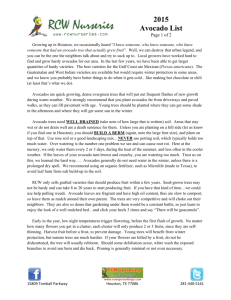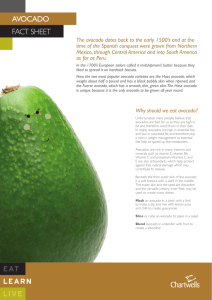Avocado Growing Guide: San Antonio, Texas
advertisement

AVOCADO GROWING IN AND AROUND SAN ANTONIO - CULTURAL INFO The avocado is a dense, evergreen tree. It is fast growing and in the tropics, can, with age, reach 80 feet, although in Central South Texas usually less. This tropical fruit tree generally branches to form a broad tree to about 12-14 feet in SC Texas. Some cultivars are columnar, others selected for nearly prostrate form. Growth is in frequent flushes during warm weather in southern regions with only one long flush per year in cooler areas. Grafted plants normally produce fruit within one to two years (nursery pot size) compared to 8 - 20 years for seedlings. West Indian type avocados produce smooth round, glossy green fruits that are low in oil and weigh up to 2 pounds, but are not cold hardy. Guatemalan types produce medium ovoid or pear-shaped, pebbled green fruits that turn blackish-green when ripe, but are not cold hardy. The fruit of Mexican varieties are smaller (8 - 12 ounces) with paper-thin skins that turn glossy green or black when ripe and are moderately cold hardy once established. The flesh of avocados is deep green near the skin, becoming yellowish nearer the single large, inedible ovoid seed. The flesh is hard when harvested but softens to a buttery texture. The Avocado fruit is an important food in South America and is nutritious with high levels of mainly unsaturated oils, minerals, vitamins and reasonable levels of protein. Clinical studies have shown that avocado oil can reduce blood cholesterol. The name 'Avocado' originates from the Aztec name ahuacacuauhitl, meaning testicle tree! Avocado trees produce thousands of flowers and only about one in 5000 flowers sets fruit. The Avocado is remarkable in its ability to thrive under a broad range of environmental conditions. It needs water and no frost and prefers good drainage, sun, and dry air. Suggested Varieties: Fantastic Avocado Green, paper thin skin, the most cold hardy of all the Mexican avocados. The fruit has a creamy texture with fantastic flavors. It has a vigorous growing beautiful tree. Hardy down to 15 degrees. Joey Avocado Founded by Joey Ricers in Uvalde, Texas. The egg shaped fruit is medium in size. It has excellent flavor the skin is purple-black in color. Heavy producer. 17 degrees. Lila Avocado Medium sized pear shaped fruit. Lila has a rich Mexican Avocado flavor. The fruit ripens from September to October. Lila is very cold hardy down to 14◦F. This tree ranges from 10’-15’ in height. Mexicola Grande Avocado This high quality fruit is indeed a true avocado variety. It has a glossy, amber, nearly black, thin skin and rich, nutty flesh. Fruit size can range from four ounces to eight ounces. Fruit begins to ripen from August through November. Hardy to about 18° F. Winter Mexican Avocado Winter Mexican variety is one of most cold hardy varieties, Guatemalan x Mexican origin. Mature trees may withstand temperatures in the mid 20s. Oblong fruit, 12 to 18 Oz, thick green skin, medium seed. Tree bears in DecemberJanuary. Trees are hardy to temperatures indicated only when fully mature and will require needed protection for up to 3 to 5 years. Page 1 of 2 Once established, avocados are fairly tough trees. However, many avocados fail during the first 24 months due to poor soil drainage, sunburn or improper irrigation habits. Follow these easy guidelines for success. Care of Avocado Trees Prior to planting: Keep avocado in the pot until late March and bring inside if there is going to be a frost or freeze. Selecting a Planting Site: Avocados are large plants. They can grow to 30 feet tall and their footprint can be 15’ or 20’ across. Of course, you can prune them to be smaller. They like as much sun as you can provide. They like to be well drained after a rain or watering. So, a large sunny spot with good drainage is best. How to plant: Avocados require a very specific planting technique. It is best to build a raised area at least 3’ in diameter and about 1’ high. Once you have this raised area built, plant in the middle of that area, but unlike any other fruit tree or plant that you would plant, you want to plant deep into the raised area. In other words, you are forming a bowl within the raised area and planting in that bowl. When you are finished planting, the plant will be in a bowl with the graft still above the soil line at the bottom of the bowl. Over the course of 18 months to 3 years, soil will be slowly added into the bowl until the graft is completely under ground, Mexican avocado. Photo by which will provide freeze protection. Following is another way to describe the TreeSearch Farms. planting process (Avocado grafts are commonly inserted quite close to the soil line of the rootstock. It is common practice to plant the tree deeper than normal so that the graft is at or below ground level. In addition, soil is mounded around the trunk as the tree grows to assure that the graft union is below ground. Thus, trees killed to the ground by severe cold will regenerate from varietal wood rather than from rootstock). Cold and heat protection: Avocados need protection from both frosts and the sun for the first couple of years. Protection from frosts and freezes: When a severe freeze is being forecast, mound additional soil around the trunk for extra protection, then water thoroughly two or three days before the cold weather is expected. Young trees can be draped (not wrapped) with a blanket or quilt (never plastic) during the freeze event. The corners of the covering should be pulled outward and anchored to the ground. Any additional practical heat source under the tented tree will probably save even the leaves. Examples include incandescent lights, decorative lights, electric heaters and camp lanterns or stoves. Once the avocados have a couple of years growth, they will not need this protection, for the varieties sold at the fruit tree sale are cold hardy. Protection from the sun: Avocados have almost no brown, woody bark like other plants. Notice that the stems and main branches of your tree are bright green. These branches and stems are photosynthesizing and providing food and energy for your tree, just like the leaves. However, this green tissue on the stems and bark is very susceptible to sunburn. Young trees do not have enough leaves to shade this bark and some special care should be given during this first year or two. One option is to paint the green trunk and main branches with a whitewash. This can be easily made by diluting a white latex paint with an equal part of water and painting it on the trunk and branches, but not the leaves. Reapply as needed until the tree grows enough foliage to shade itself, usually within a year or two. Another option is to build a simple structure of metal, wood or PVC to which can be attached a cloth that will keep the mid-day and afternoon sun off the trunk. A burlapcovered cage about a foot higher than the tree is commonly placed around the tree in the Valley for both shading and wind protection. Fertilizing: Commence feeding of young trees after one year of growth, using a balanced fertilizer, four times yearly; but all fertilizing is done after blooming when fruit is set. Watering: After drainage, proper irrigation is the most critical factor effecting the establishment of your new avocado. Unless drainage is quick, even the most careful attention to watering will not help. Over irrigation can induce root rot, which is the most common cause of avocado failure. To Avocado tree. test to see if irrigation is necessary, dig a hole a few inches deep and test the soil by squeezing. If it is moist (holds together), do not irrigate; if it crumbles in the hand or is obviously dry, it may be watered. Never enter winter with wet soil. Avocado trees may not need irrigation during the winter rainy season, but watch for prolonged mid-winter dry spells. Harvesting: Avocado fruit does not ripen on the tree; nor does it fall to the ground when ripe. Avocado maturity, if unknown, can be easily determined, as the fruit is mature when it will soften to good eating quality. Most of the avocados will be ready to pick in the early fall. Pick a couple of fruit and set them on the kitchen counter (out of direct sun). A mature fruit will soften within three days to two weeks. If the fruit don't soften, try again every week or so with new fruit until you achieve softening and good taste. A key to harvesting is picking the fully grown fruit and allowing the smaller fruit to grow big before picking. Mexican variety avocados, the kind sold at the fruit tree sale, are thin skinned and will not store for a long time, so they must be used shortly after harvesting. If fruit is high on the tree, use a long handled picking pole with a sharp “V” on the metal rim to cut the stem and a strong cloth bag to catch the fruit. Other desirable varieties of Avocados Opal® Originated in Uvalde, Texas. This is a cold hardy Mexican avocado. The medium sized pear-shaped fruit is very rich tasting. The skin is green in color. Wilma™ Originated nearPearsall,Texas. This is a cold hardy Mexican avocado The fruit is large in shape and has a very good flavor. The skin is black in color. Poncho A medium-large green fruit, cold hardy Mexican avocado. PAGE 2 of 2









